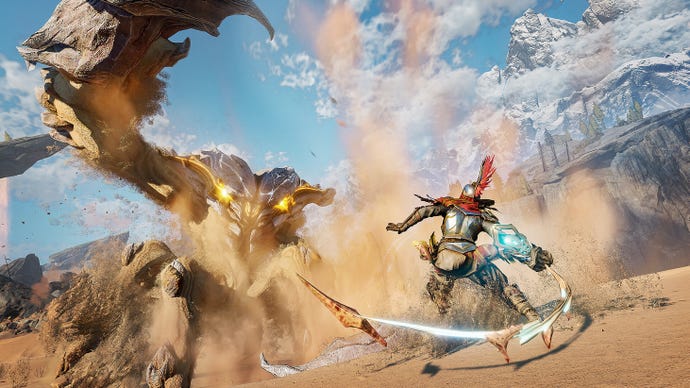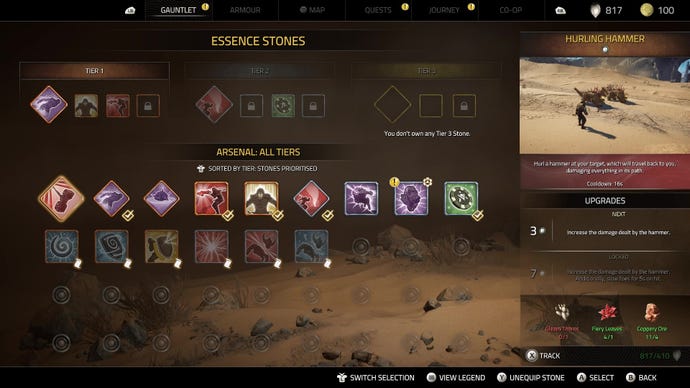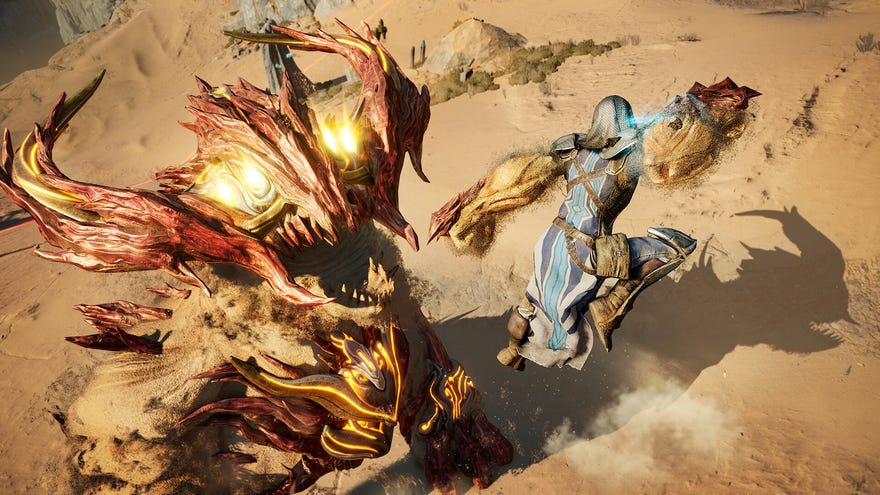Atlas Fallen review: middling action adventuring upheld by (mostly) stellar combat
Worth poking your eye out of the sand, at least
If I could distill Atlas Fallen I'd say it's like going to a video game store, rifling through the pre-owned shelves, and selecting a purchase based purely off what's most likely to deliver an average-to-good time. Bulky pauldrons and a glowy blue gauntlet? Perfect. Set your expectations low and you've got a game with genuinely great fights against dusty crabs, mixed with acceptable open world-ish fetch quests. Just don't ever let your expectations rise, otherwise frustrations with some of its jank might tip you over the edge... and you might realise there's plenty else you could play.
Broken up into open zones, the game's main quest centres around overthrowing the evil queen of the land. She's said to have exacted nasty god Thelos's bidding, which was to unleash a horde of feral demons to keep folks in check. The queen has installed a floating helmet with big red eyes in the sky as a precautionary measure, just in case people step out of line. With slight Forspoken energy, it turns out you're the perfect fit for a special gauntlet, a mystical metal glove which harnesses the power of some Avatar-looking geezer called Nyaal.

"Nyaal" is the sound I make when I have to find yet another crystal to make my gauntlet strong enough to advance the story. Not that the story's awful, it's more the way it's executed with a fantasy jank that, well, tries very hard in a sort of endearing way. You're guided through the grand tale of Thelos by a slightly dodgy set of quest markers, all of which may or may not lead you to lots of fetch quests and tepid open world fare like smashable statues and sparkling animals that'll dig up bits of treasure map. No matter what, you'll soon come to realise the gauntlet isn't all that exciting.
As you rebuild your gauntlet, you first gain the power to lift platforms buried under layers of sand, then eventually the power to conjure hidden pathways. You might think it exciting, this ability to manipulate the very granules of the land! Surely, it would mean a swathe of new traversal possibilities? Or at least an "aha!", as you remember the glowing doorway you definitely couldn't open earlier on? No, not really. The gauntlet's powers are only to be used in specific spots to advance a story beat, or to reach a chest with some tradeable horse toy in it. Aside from being a great surface to skid on, the sand is more set dressing and the gauntlet surprisingly dull for all of its mystical, god-defying powers.
But to be fair to each region, they're quite nice to look at. You've got crumbled ruins towering into the sky, with lovely Middle Eastern-inspired architecture giving a city or two a nice atmosphere. And there's a great sense of scale as you glide across dunes and run straight into some colossal crab carved from stone. There's only one underground area which feels out of place, purposefully robbing you of the freedom to bound about and soak in the expanse. Presumably it was intended as a change of pace, but it upset the smile-and-forgive relationship I'd built with Atlas Fallen's flaws, and almost pushed me into a misery pit I thought I wouldn't climb out of. Prepare to steel yourself for that from time to time.

Where Atlas Fallen pours a lot of its resources is in making combat a weighty affair, with interesting combos and a fair amount of customisation. Fights consist of ground and aerial combos, with two weapons mapped to your button presses (don't even think about playing with keyboard and mouse). Out of three total weapons - an axe, a whip sword, big fists - I opted for the fists and whip, as it let me dish out damage up close and unleash some long range tickles when needed. Combos are a genuine delight, with fluid animations and a real sense of heft as you clatter your attacks into dusty crustaceans and/or snarling mammals.
What's neat about fights is the momentum meter, a blue bar that builds as you hurt baddies. As it fleshes out, you'll not only deal more damage, but your weapons become flashier and dish out more elaborate combos. To fell some of the beefiest baddies you'll need to target several body parts, each complete with their own health bars. If you build up the momentum meter enough, you can actually initiate a Shatter attack that'll destroy a body part in one massive go - but you'll reset your momentum back to zero. So, some of the toughest fights become an interesting juggle as to whether you spend your momentum to guarantee a chopped limb, or to save it and dish out more hurt, more consistently.
I genuinely think the momentum bar is a brilliant way to add motivation to prolonged fights, creating a power fantasy waiting to be fulfilled as you survive the sandy hordes. Plus, the fun doesn't stop there. The bar is split into three sections: tier one, two, and three. Each segment can be outfitted with the equivalent of perks that'll automatically activate as you build up enough momentum juice in fights. The first tier might hold basic damage upgrades or dash attacks, but reach the higher tiers and you'll be able to summon crackling tornados or generate chunks of momentum off successful parries. And it's not for show either, as I found myself seeking out materials to buy cool ones or swapping them out between tough fights. I repeat: the momentum system is great!

Combat isn't perfect, though. Often, fights contain one hulking lad and several smaller boys either in the sky or flitting about on the outskirts ready to strike. Often either the camera struggles to cope as you swap between target-locks, or, because there are so many little bastards, you'll struggle to target the one you want. Many of the toughest fights also commit the cardinal sin of periodically dumping filler enemies on you, just to pad out the challenge with critters. I hate this. I hate when games do this.
Levelling is also quite counter-productive, as it's tied to how much you invest in the armour you've popped on. Armour has a base level - say, three, for instance. And each piece of armour can be upgraded a maximum of three times with materials you'll earn by exploring or defeating monsters. So, you might invest heavily in your level three armour in the hopes of turning it into a six, right? Well, the game has a frustrating habit of dishing out armour with higher base levels at certain story intervals. You might've got that three to a six - but get fucked! Here's a level four piece that can be upgraded to a maximum of seven! You'll need higher level armour to tango with tougher monsters, so you can't ignore it either. This continues throughout the story, to the point where you're punished for spending and will almost certainly develop an uneasy feeling about doing so.
It's very much a middling time, in other words. Atlas Fallen fulfils the joy of picking up a pre-owned six-out-of-ten at GameStation and going with whatever happens on screen. You'll teeter on a knife edge mentally, as you accept its tedious fetch quests and just fine platforming fare, perhaps occasionally letting out your frustration with a quit to menu as boss fights take the piss, or a quest once again asks you to fetch yet more crystals. Still, the combat is surprisingly robust and its momentum schtick is a proper thrill once you've got the flow down. If anything, it's the combat that'll make you stick around. That is, until you realise there's a lot of other good open world games you could be playing instead of Atlas Fallen.

